InvestigativeMEDIA is republishing its 2012 series of stories on the original investors of the Rosemont Copper Mine and their role in a failed Sardinian gold mining project through a Vancouver, B.C. based mining company called Sargold Resource Corp.
One of the original Rosemont investors, Richard Warke, remains a key player in Arizona by seeking permits to develop a massive open-pit silver mine near Patagonia. Warke is now chairman of Arizona Mining Inc., which is seeking state and federal permits to develop the Patagonia mine.
Warke runs an array junior mining companies from Vancouver, B.C. and also serves as Executive Chair of NewCastle Gold Ltd., a company focused on exploring its multi-million ounce gold deposit in California.
These businesses are part of the Augusta Group of Companies, a conglomerate that Warke founded in 2006 comprised of Arizona Mining, NewCastle Gold Ltd. and Armor Minerals.
As detailed below, Warke’s management of Sargold Resources and its Sardinian gold mine raise serious questions. For additional information on Warke’s history of failing to disclose personal and corporate bankruptcies, cease trade orders and stock exchange delistings click here. A video timeline of Warke’s business history is here.
Warke is also featured in InvestigativeMEDIA’s 2012 award-winning documentary Cyanide Beach.
InvestigativeMEDIA’s series of stories on Warke and his business partners including the Sargold investment was later featured in Global Mining Observer.
Toronto-based Hudbay Minerals Inc. purchased Rosemont Copper when it acquired Augusta Resource Corp. in 2014 in a $550 million stock deal. Warke was Chairman of Augusta Resource at the time of the purchase. Augusta Resource, under Warke’s direction, purchased the Rosemont copper prospect for $20 million in 2006.
Hudbay is now seeking state and federal permits to develop the Rosemont mine. InvestigativeMEDIA released its documentary Flin Flon Flim Flam on Hudbay’s worldwide operations and plans to develop the Rosemont mine in October 2015.
InvestigativeMEDIA’s original 2012 story on Warke’s investment strategy in the Sardinian gold mine through the now defunct Sargold Resource Corp. follows below.
Introduction
Augusta Resource Corporation is seeking government approvals to construct a massive  open-pit copper mine and dump waste rock and mine tailings on more than 3,000 acres of the Coronado National Forest in the Santa Rita Mountains 35 miles south of Tucson.
open-pit copper mine and dump waste rock and mine tailings on more than 3,000 acres of the Coronado National Forest in the Santa Rita Mountains 35 miles south of Tucson.
The mine would be operated through Augusta’s wholly-owned subsidiary, Rosemont Copper Company. ![]()
Augusta, a Vancouver, British Columbia speculative mining company, has never operated a mine and has a very limited business history.
Five of the eight current members of Augusta’s board of directors, however, do a have mining history.
Between 2003 and 2007, these executives were on the board of directors of Sargold Resource Corporation. Sargold owned and operated an open-pit gold mine near the small farming village of Furtei in south-central Sardinia.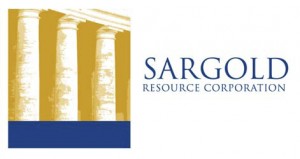
InvestigativeMEDIA reviewed Sargold’s publicly available business records and traveled to Sardinia and Vancouver to conduct interviews. The reporting lead to the video documentary “Cyanide Beach”.
InvestigativeMEDIA also prepared the following report on Sargold’s business history that includes a detailed analysis at the end of the historical narrative.
InvestigativeMEDIA offered to meet Augusta officials in Vancouver, but Augusta declined interview requests with the five current Augusta board members to discuss their actions as Sargold directors.
The history and analysis is annotated with links to Sargold’s press releases, regulatory disclosures, court records, Canadian mining claim reports, news articles and scientific studies on the unfolding environmental disaster left behind after the Sardinian gold mine was abandoned.
Sargold’s Sardinian Play
Sargold Resource Corporation (previously 3423786 Canada Inc., 5/1998; Augusta Corp., 7/1998; Canley Developments, 8/2001; Sargold, 7/2003) operated an unprofitable gold mine and held exploration rights for two gold mining claims in Sardinia, Italy between 2003 and 2007.
Sargold’s Board of Directors included five of the eight current directors of Augusta and one former Augusta board member.
The common Sargold and Augusta directors include: Augusta Chairman Richard Warke, Augusta President and CEO Gil Clausen, and directors Donald B. Clark, Robert P. Wares, Christopher M. H. Jennings. Former Augusta director Michael A. Steeves also served on the Sargold board.
Sargold’s history provides the only example of how the majority of Augusta’s current board managed an active mining company in the immediate past.
Sargold’s corporate records and interviews with key officials in Canada and Italy familiar with Sargold’s operations reveals a troubling history that includes:
* Failure to provide accurate and timely information to shareholders.
* Failure to pay vendors.
* Misspending a Sardinian government loan.
* Evidence of a self-enrichment scheme to benefit its chairman.
* Evidence of insiders receiving excessive discounts on stock purchases.
* Issuing misleading press releases.
* Not disclosing in proxy statements that a Cayman Islands investment fund controlled more than 10 percent of the company between 2005 and 2007.
* Contributing to an ongoing environmental disaster in Sardinia.
Sargold’s Sardinian investment
Sargold’s primary asset was its Italian subsidiary, Sardinia Gold Mining, SPA (SGM).
In March 2003, Sargold, then known as Canley Developments, entered the Italian gold mining business through a joint venture with Australian-based Gold Mines of Sardinia. Gold Mines of Sardinia held a 90 percent interest in Sardinia Gold Mining, SPA.
In June 2003, Sargold signed a purchase agreement to buy 50 percent of GMS to take a 45 percent interest in Sardinia Gold Mining.
In early 2004, Sargold issued two press releases concerning Sardinia Gold Mining’s primary asset, the Furtei Gold Mine. The first release touted “significant increases in gold grade”; and the second announced discovery of a “substantially larger resource than was originally estimated”.
In June 2004, Sargold announced plans to purchase the remaining 45 percent interest from the Australian company to up its stake in Sardinia Gold Mining to 90 percent. Progemisa, an Italian government mining research organization, owned the remaining 10 percent.
A month later, in July 2004, Sargold issued a press release hailing its drill exploration program that had discovered the “highest gold grades” to date at the Furtei mine.
Sargold closed the purchase in September 2004 and assumed control of Sardinia Gold Mining’s assets, including the Furtei open pit gold mine and exploration rights near the historic Sardinian town of Osilo.
In October 2004, RAB Special Situations, a Cayman Islands hedge fund, purchased 4 million units of Sargold in a private placement to take a 26 percent stake in the company. RAB Special Situations made additional major purchases through private placements in 2006 and 2007. Sargold did not report RAB’s 10 percent or more share of the company’s stock as required by Canadian financial regulations in its annual proxy statements between 2005 and 2007.
In November 2004, Sargold issued another optimistic press release describing its “in-ground gold resources, hundreds of square kilometers of prime gold exploration ground, a permitted production facility and over ten years of detailed geological information.”
In early 2005, Sargold appointed Franco Cherchi president of Sardinia Gold Mining.
This was a very high-profile appointment in Sardinia. Cherchi was a former president of Progemisa, the government-funded mineral resource management agency and Sargold’s 10 percent minority partner in Sardinia Gold Mining. He was also involved in Sardinian regional politics and was a regional leader in the Left Democratic Party.
“Mr. Cherchi brings extensive experience in geology, administration and local politics to his new position,” Sargold noted in a Jan. 19, 2005 press release.
Furtei’s limited prospects
The Furtei gold mine, is located within a volcanic cinder cone near the small town of Furtei in Southern Sardinia.
The mine complex is also wedged into the middle of an important water and hydroelectric facility that serves southern Sardinia, including its capital, Cagliari.
The Sa Forada water/electric infrastructure includes the Sa Forada Dam and reservoir, underground pipelines, a hydro-electric power plant and a high-tension electricity power grid. The complex was constructed in the 1970s with European Union funding.
Sardinia Gold Mining began operations at the Furtei open pit mine in 1997.
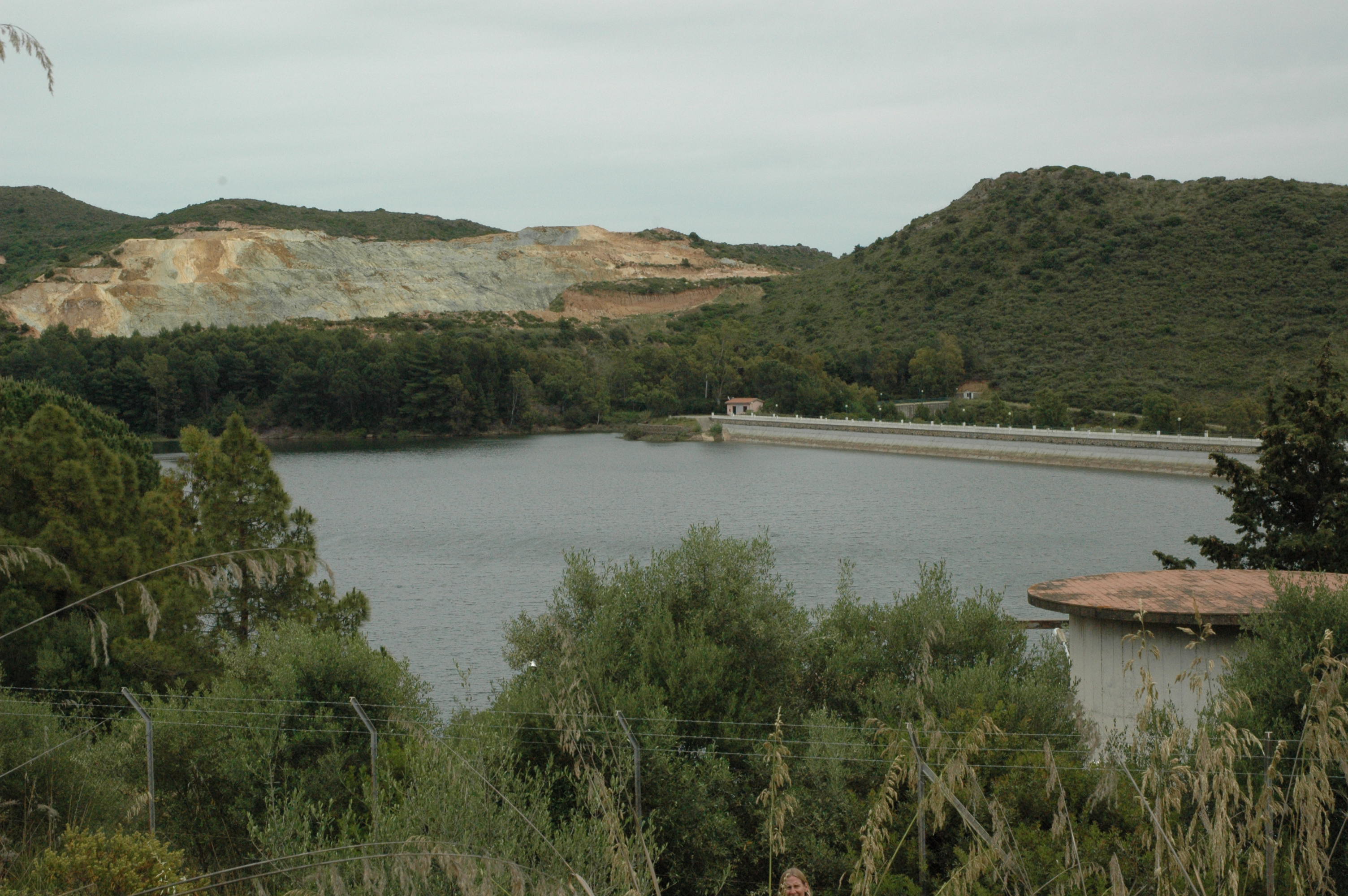
The Sa Forada Reservoir supplies drinking and irrigation water to southern Sardinia. Mining operations stripped away the earth next to the reservoir.
The Australians closed the mine in 2002 after all accessible oxide ore had been removed. About 138,000 ounces of gold were produced.
After assuming full control of Sardinia Gold Mining in 2004, Sargold refurbished the Furtei mine’s milling facilities. Between March and September 2007, Sargold produced 1,300 ounces of gold and silver from waste rock.
Sargold’s business plan was to reopen and expand the Furtei gold mine and use revenue 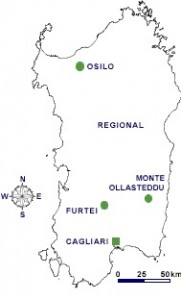 from the sale of gold ore to finance exploration and development of additional potential underground sulfide gold resources at Furtei and explore and develop mining claims near Osilo and on Monte Ollasteddu.
from the sale of gold ore to finance exploration and development of additional potential underground sulfide gold resources at Furtei and explore and develop mining claims near Osilo and on Monte Ollasteddu.
Major Obstacles
Sargold’s business plan faced serious obstacles from the start. These challenges were described in detail in a November 2003 proxy statement prepared by Full Riches Investments, a company that was created to facilitate the sale of Gold Mines of Sardinia.
The issues included:
*All readily accessible oxide ore had been removed from the open pit and Sardinia Gold Mining determined in 2002 that underground mining would be unprofitable.
*The Sa Forada Dam and hydro-electric facilities restricted blasting and impinged on the possible expansion of the Furtei open pit mine and the possible development of an underground mine.
*The remaining gold ore was embedded in a type of rock formation that required expensive and untested methods to extract the gold.
*Opposition in Osilo to mining was significant and opponents had the support of key Italian government agencies.
*Access to Monte Ollasteddu was restricted because it was adjacent to an air base and required military approval.
Ignoring Reality
Sargold glossed over the fundamental challenges in its financial statements and management discussion and analysis reports submitted to Canadian securities regulators.
Instead, Sargold touted rich gold strikes from exploratory drilling and unsubstantiated claims of gold reserves in its press releases, including a 2003 release issued when Sargold, then known as Canley Developments, announced its intent to purchase 45 percent of Sardinia Gold Mines.
The March 26, 2003 press release claimed, among other misleading statements, a “600,000 ounce gold resource” at Furtei. Three months later, the Toronto Venture Stock Exchange forced the company to retract numerous statements concerning gold reserves.
The full extent of the problems facing Sargold did not become apparent to the public and investors until December 2006, when the company restated its financial statements for the previous three years. The restatement was issued after the company reported it failed to properly account for taxes related to the purchase of the Furtei mine and another asset.
Sargold’s December 2006 Management Discussion & Analysis provided details to the public and investors about the company’s failure to pay contractors on time, misspending a government loan and the serious obstacles to conducting exploration at Osilo and Mounte Ollasteddu.
By December 2006, Sargold owed more than $1.5 million to its suppliers and contractors, with 85 percent of the payables more than six-months past due. Vendors filed law suits in local Sardinian courts and won judgments.
The December management report also revealed Sargold misspent a Sardinia Regional Financial Institute loan that was intended to develop an underground mine. Sargold spent the money on other operations and the Sardinian government demanded repayment of $787,000.
Withholding key information
At the same time the company’s financial condition was steadily deteriorating, Sargold withheld key information from shareholders.
For nearly three years, the company did not publicly identify in its annual proxy statements to shareholders that RAB Special Situations, the Cayman Islands hedge fund, controlled more than 10 percent of the company’s stock. Canadian disclosure laws require companies to disclose the identity of an investor that controls more than 10 percent of the outstanding shares. (See Analysis, Chapter V, below)
Although Sargold insiders, including several board members, participated in the private placements with RAB Special Situations in 2006 and 2007, Sargold did not disclose RAB Special Situation’s major investment in Sargold’s annual proxy statements in 2005, 2006 and 2007.
RAB’s dominate position in the company was not reported in Sargold proxy statements until days before an October 2007 merger with Buffalo Gold Ltd.
Lodestone — an example of self-enrichment
Four years earlier, Sargold entered into an unusual agreement with its chairman, Richard Warke.
In March 2003, Sargold (then known as Canley Developments) purchased four mining claims owned by a company controlled by Warke. Sargold purchased Warke’s company for $688,000 in cash and stock to assume control of the four iron ore mining claims. Warke had acquired the mining claims from his late father’s estate.
Four years later, and after reportedly spending $175,000 on a drilling exploration program, Sargold declared the iron ore project was worthless and wrote off $1.2 million.
In the fall of 2007, Sargold reported in regulatory filings that the Lodestone iron ore claims had been sold to an unidentified buyer for $1.
Canadian mining claim records, however, reveal that Sargold sold the claims back to the Warke-controlled company in October 2007.
And, rather than the claims being worthless, Warke’s company immediately spent $10,000 to keep the claims in good standing with Canadian mining regulators.
The $10,000 investment was made at the same time Sargold approved the sale of the mining claims for $1.
Warke’s company continues to control the claims and has spent $50,000 over the last five years to maintain the claims in good standing with Canadian mining regulators. (See Analysis, Chapter III, below.)
In the mid 1990s, Warke was facing personal financial ruin. He was repeatedly sued by various financial institutions and in September 1998 he filed a bankruptcy proposal. The bankruptcy case dragged on for more than four years, with Warke defaulting on the settlement terms in October 2002. Warke settled the case in November 2002.
Sargold does not reveal Warke’s personal bankruptcy proceeding in its proxy statements and annual reports as required by Canadian disclosure regulations until the May 2006 proxy.
Warke’s bankruptcy filing came 9 years after he signed a settlement agreement with the British Columbia Securities Commission on an insider trading violation. Warke agreed to settle allegations he filed knowingly false insider trading statements and paid a $500 fine.
Blue sky
At the same time Sargold was failing to disclose required information to regulators, Sargold continued to issue optimistic press releases over its Sardinian gold mining prospects, despite mounting financial problems that forced Sargold executives to make personal loans to the company in late 2006 and early 2007.
In a March 28, 2007 press release, Sargold reported “significant breakthroughs” in developing a new process to extract gold from rock formations that had limited Furtei gold production in the past.
On May 14, 2007, Sargold announced a huge increase in planned gold production. The press release claimed Sargold would produce between 10,000 and 15,000 ounces of gold within the next 12 months before ramping up to 60,000 to 70,000 ounces the second year and leveling off to 50,000 ounces a year for five years.
Buffalo stampede
At the same time Sargold was issuing press releases touting revolutionary processing techniques and massive increases in gold production, the company was selling millions of share of stock.
In June 2007, RAB Special Situations purchased 7.5 million shares in a private placement, increasing its stake in the company to 33 percent of the outstanding shares. Warke purchased 1 million shares in the same private placement through his privately held investment company, Augusta Capital.
RAB and Augusta Capital paid $.20/share.
Less than a month later, Sargold announced it had reached a merger agreement with another Vancouver, B.C. junior mining company, Buffalo Gold Ltd.
On Oct. 26, 2007, Buffalo Gold acquired all of Sargold’s stock and took over operations of Sardinia Gold Mines.
Buffalo Gold paid a significant premium for Sargold in the stock swap that exchanged one  share of Buffalo stock for 3.5 shares of Sargold stock. Sargold shareholders were paid approximately $.25/share.
share of Buffalo stock for 3.5 shares of Sargold stock. Sargold shareholders were paid approximately $.25/share.
One month prior to the October 2007 merger, Sargold revealed for the first time in its proxy statements that RAB Special Situations controlled more than 10 percent of the company’s stock — 19 million shares, equal to 34 percent of the company’s outstanding shares. (See Analysis, Chapter IV, below.)
RAB Special Situations appears to have had a vested interest in the Buffalo-Sargold merger.
The Cayman Islands hedge fund had also been a major shareholder in Buffalo Gold. RAB Special Situations controlled 9 percent of Buffalo Gold’s stock in October 2006, according to the last public filing before the Sargold merger, and as much as 22 percent of Buffalo’s stock as of February 2006.
Losing millions
After the merger, Buffalo Gold continued gold exploration at the Furtei Mine and in September 2008 announced a gold sulfide resource of 425,000 ounces. But extracting the gold proved to be very expensive. Buffalo Gold’s investment in Sardinia Gold Mining resulted in more than $5 million in losses from the time of the merger in October 2007 to the end of 2008.
In December 2008, Buffalo Gold forfeited control of the Furtei gold mining operation. Canadian securities regulators issued Buffalo Gold a Cease Trade Order on May 11, 2009, after Buffalo Gold failed to file audited financial statements for 2008.
Sargold stated in a December 2006 financial statement (Note 9) that it had set aside $1 million for environmental restoration. The company reported:
“SGM has provided for costs to rehabilitate the properties in Sardinia. The environmental monitoring plan in place aims to ensure that the mining, processing and rehabilitation work are all carried out in a manner which conforms to legal requirements, and further to ensure that environmental impacts of the project are minimized. This activity includes the backfilling, contouring, covering with topsoil and replanting trees and shrubs to land previously disturbed by exploration and operations. The amount accrued attributable to mine rehabilitation is $980,305.”
The cleanup was never completed.
Sargold’s September 2007 merger with Buffalo Gold and Buffalo’s subsequent abandonment of the mine site has created an unfolding environmental disaster that threatens to pollute the ground water.
The Sardinian regional government is conducting a $4.5 million remediation study of the abandoned mine site and clean up is estimated to cost at least $20 million.
A 2008 University of Cagliari report determined that “the highest potential threat for the environment is mostly represented by mineralized rocks exposed in waste dumps and open pits.”
A 2011 University of Cagliari report concluded:
“The waters draining the mining area have high acidity and elevated concentrations of metals. The main sources of contamination are waste materials disposed on dumps, flotation tailings confined in an impoundment, and mineralized rocks exposed in open pits; these materials have a high capacity of acid drainage generation and release of extreme concentrations of contaminants.”
ANALYSIS
CHAPTER I
Lack of full disclosure
Sargold knew prior to purchasing the assets of Sardinia Gold Mining that there were severe limitations to successfully resuming gold mining operations.
Sardinia Gold Mining had three primary assets:
*The Furtei open pit gold mine and processing plant;
*Osilo mining claims
*Mt. Ollasteddu mining claims.
Limitations at Furtei
A November 2003 proxy stated the Furtei open pit gold mine was already depleted of readily accessible oxide ore. The disclosure also concluded that underground mining for sulfide ores would not be profitable because of limited quantity and the low price for sulfide concentrates.
“The mine ceased production in February 2003 after all economic open pit ore sources were mined and oxide resources were depleted, pending a decision to exploit sulphide mineralization from underground operations. Sardinia Gold has evaluated possible underground mining of known sulphide resources lying beneath the exhausted surface pits. Internal studies have shown this to be marginally economic and dependent upon potential local government grants, due to the extremely small amount of mineable resource, the capital requirement and the low revenue expected from the sale of sulphide concentrate.”
The report also disclosed that possible expansion of the open pit and development of an underground mine faced serious infrastructure limitations. The disclosure stated that the Sa Forada Dam and hydro-electric generating plant would restrict exploration and could seriously limit the expansion of the open pit mine and development of an underground mine.
“(A consultant) received several opinions from Sardinia Gold staff on mining restrictions related to this infrastructure adjacent to the Sa Forada Dam and reservoir. Vibration restrictions near infrastructure also restrict blasting or modify blasting patterns in some areas. The relocation of some powerline infrastructure may be required upon new discovery and subsequent mining development and infrastructure may hinder extensive new open pit or underground development.”
Opposition at Osilo
The November 2003 proxy also disclosed the Osilo mining prospect was facing significant public and political opposition that had stalled previous attempts to explore the mineral claims located near the historic town.
“Sardinia Gold has received notice in 2003 that the Council of State has upheld the appeal of the Sassari Ministry of Environment and Cultural Heritage against a previous ruling of the Sardinian Regional 44 Administration Tribunal which overturned the veto on the commencement of trial underground mining at Osilo.”
Military Approval needed at Mt. Ollasteddu
The disclosure also revealed the Mt. Ollasteddu claim faced a serious development obstacle because it is adjacent to an Italian military airfield. Year-round road access to the site needed military approval, which had not been granted at the time Sargold purchased SGM, nor was it ever obtained.
“The tenement for Monte Ollasteddu has been granted by the Italian Mines Department. However, drill permit access to the prospect is presently awaiting formal approval from the Ministry of Defence in Rome. Paved road access comes to within 2 kilometers of the area on the northern side of the plateau and an unpaved and sinuous track provides poor access to the south of the property at the base of the valley. Road access to the northern side of the property is possible year-round but only with military permission.”
Chapter II
Misleading press releases
A. On March 26, 2003, Canley Developments Inc. (Sargold’s previous name) issued a press release stating it had reached an agreement with Gold Mines of Sardinia (“GMS”) to joint venture the Furtei Gold Mine on the island of Sardinia. The release stated in part:
“This open pit operation consists of a full production facility capable of processing 1,000,000 tons of ore annually, a 600,000 oz gold resource, freehold land and buildings and over 10 sq. km’s of exploration property.”
On June 12, 2003, the Toronto Venture Exchange forced Canley to retract key statements. Sargold was forced to retract its statement of a 600,000 oz gold resource, among other claims. Records show Sargold grossly over stated the size of the gold processing plant, claiming it could process 1,000,000 tons of ore annually. In 2006, Sargold revised that number downward 66 percent, to 365,000 tons annually.
Chapter III
Lodestone: Evidence of self-dealing
In 1991, Richard Warke’s father, William Warke, acquired the Lodestone Mountain mining claims. The four, iron-ore claims are located about 125 kilometers east of Vancouver. William Warke died in 2002 and Richard Warke inherited the claims.
Richard Warke incorporated 651030 B.C. Ltd. in July 2002 to hold the Lodestone claims.
The first major transaction by Sargold after its shares of stock resumed trading in Feb. 2003 (shares had been suspended for four months because the company failed to meet minimum capital standards) was to acquire the Lodestone mining claims from its chairman.
On March 3, 2003, Sargold signed an option agreement with 21st Century Energy Corp., a company controlled by Warke, to acquire 100 percent working interest in the Lodestone mining claim in a cash and stock deal worth $688,666.
The Sargold board approved the purchase at the May 2003 annual meeting. The Sargold board members who approved the Lodestone acquisition from Warke’s company and who now serve, or served, on the Augusta board include: Clark, Jennings, Wares and former Augusta board member Steeves.
(Note: Sargold’s May 2004 proxy identifies 21st Century Energy as the seller of Lodestone. Beginning with Sargold’s June 30, 2004, management discussion and analysis, the company states Sargold acquired 100 percent of the stock of 651030 B.C. to acquire the Lodestone claim.)
Sargold paid 21st Century Energy/Warke 3.166 million shares stock (valued at $.15/share with 2 million shares held in escrow for an undefined period), 3 million warrants (valued at $120,000) and $100,000 cash.
In 2004 and 2005, Sargold reportedly invested approximately $175,000 in mining exploration on the property, according to Sargold’s financial reports. But Sargold never developed the project.
In the third quarter of 2007, Sargold wrote-off $1.17 million on the Lodestone investment. The company then reported it sold the Lodestone mining claim to an undisclosed entity for $1 in November 2007.
British Columbia mining claim records show that Warke’s company, 651030 BC re-assumed control of the Lodestone claims on Oct. 3, 2007.
Therefore, records indicate Sargold sold the claims it had purchased from Warke’s company for $688,666 in cash and stock in 2003, back to Warke’s company for $1.
Canadian mining records also show that 651030 B.C. made cash-in-lieu payments to the government of $10,000 a year in 2007, 2008, 2009 , 2010 and 2011.
The cash-in-lieu payments were made to maintain ownership of the claims rather than making direct investment on the land.
The mining records show that 651030 BC made the first cash-in-lieu payment on Oct. 3, 2007 — 27 days prior to the Sargold-Buffalo Gold merger.
This payment contradicts Sargold’s assertion in its 3rd quarter 2007 financial statement that the Lodestone Mountain claim was sold in November 2007.
The Oct. 3, 2007 cash-in-lieu payment also establishes an asset value of at least $10,000 for the property at the same time Sargold sold the mining claims for $1.
Warke continues to be the sole director of 651030 B.C. as of March 25, 2011.
Chapter IV
RAB Special Situation’s hidden investment
RAB Special Situation’s control of more than 10 percent of Sargold’s stock was not disclosed in the company’s annual proxy statements for nearly three years.
On Oct. 19, 2004, Sargold’s insider trading report shows RAB Special Situations purchased 4 million shares in private placement at $.30/share.
Sargold published an Early Warning Report on SEDAR’s website disclosing the RAB purchase.
The purchase represented approximately 20 percent of Sargold’s outstanding shares at the time and increased RAB Special Situation’s holdings to 5.66 million shares, representing 26 percent of Sargold’s shares on a partially diluted basis.
On May 3, 2005, Sargold’s insider trading report states that RAB Special Situations purchased 5.742 million shares for $.28/share in a private placement. NOTE: RAB Special Situations DOES NOT FILE OTHER INSIDER TRADING DOCUMENTS CONFIRMING THE PURCHASE.
Also on May 3, 2005, Sargold’s insider trading reports states that RAB Special Situations sold 5.666 million shares for $.28/share in a private sale. NOTE: RAB Special Situations DOES NOT FILE OTHER INSIDER TRADING DOCUMENTS CONFIRMING THE SALE.
On May 9, 2005, Sargold reported 40.3 million shares outstanding in its annual proxy statement. The company does not disclose that RAB Special Situations controls 5.7 million shares of the company, equal to 13 percent of outstanding shares. Instead, the proxy report states:
“To the knowledge of the directors and senior officers of the Corporation, the only party(ies) owning, directly or indirectly, or exercising control or direction over, shares carrying more than 10% of the voting rights attached to the issued and outstanding shares of the Corporation are as follows:
Number of Percentage of Name Shares Owned Issued Shares
CDS & Co.(1) 27,704,415 68.65%
(1) Beneficial owners of these shares are not known by the Corporation.
On Oct. 13, 2005, RAB Special Situations reports that it ceased to be a Sargold insider.
On May 24, 2006, Sargold reported 40.3 million shares outstanding in its annual proxy statement. The company does not disclose that RAB Special Situations controls 5.7 million shares of the company, equal to 13 percent of the outstanding shares. Instead, the proxy report states:
“To the knowledge of the directors and senior officers of the Corporation, the only party(ies) owning, directly or indirectly, or exercising control or direction over, shares carrying more than 10% of the voting rights attached to the issued and outstanding shares of the Corporation are as follows:
Number of Percentage of
Name Shares Owned Issued Shares
CDS & Co.(1) 36,110,460 89.47%
(1) Beneficial owners of these shares are not known by the Corporation.
On July 28, 2006, RAB Special Situations reports in the “alternative monthly report” that appears on SEDAR’s website for Sargold that it purchased an additional 5.4 million shares in a private placement at $.18/share. The purchase increased RAB Special Situations holdings to 11.2 million shares and 6.725 million warrants, representing 27.85 percent of the company’s partially diluted shares.
The purchase, however, does not appear on Sargold’s insider trading report.
Sargold insiders also purchased more than 2 million shares of the firm’s stock at $.18/share in the same private placement. The insiders’ purchase is reported on Sargold’s insider trading report and includes the citation “private placement, prospectus exemption”.
Sargold’s insider trading report shows the following purchases: Donald Clark (600,000 shares), Mike Clarke, (55,000 shares), Gil Clausen (300,000 shares), Purni Parikh (195,000) shares, George Paspalas (420,000 shares) Michael Steeves (170,000 shares) and Augusta Capital (1,150,000 shares). Augusta Capital was controlled by Sargold chairman Richard Warke.
On May 18, 2007, Sargold’s proxy statement reports the company had 63 million shares outstanding. The company does not disclose that RAB Special Situations controlled 11.2 million shares of stock, equal to 18 percent of outstanding shares. Instead, the proxy report states:
“The directors and senior officers of the Corporation are not aware of any party(ies) owning, directly or indirectly, or exercising control or direction over, shares carrying more than 10% of the voting rights attached to the issued and outstanding shares of the Corporation.”
On June 12, 2007, RAB Special Situations reports in an “alternative monthly report” that appears on SEDAR’s website for Sargold that it had purchased 7.5 million shares in a private placement. The purchase increased RAB Special Situation’s holdings to 18.69 million shares and 10.225 million warrants, equal to 33 percent of the partially diluted shares outstanding.
The purchase, however, does not appear on Sargold’s insider trading report.
On June 18, 2007, Augusta Capital (controlled by Richard Warke) purchased 1 million shares in the same private placement that included RAB Special Situations. Sargold’s insider trading report states that Augusta Capital’s purchase was made under a “private placement — prospectus exemption”.
On Sept. 26, 2007, Sargold, for the first time, discloses in a proxy statement that RAB Special Situations has a dominant interest in the company’s stock . The disclosure is made when Sargold issues a special proxy statement seeking shareholder approval of the Buffalo Gold merger.
The special proxy statement (page 8) reports RAB Special Situations controls 19 million shares and 10.225 million warrants, representing 34 percent of the company’s outstanding shares on a partially diluted basis.
Sargold’s directors and senior officers controlled 6 millions shares, equivalent to 8 percent of the outstanding shares.
Chapter V
Evidence of improper discount to Sargold insiders on private placements
The Canley Developments (Sargold) April 2003 prospectus exemption to the Toronto Venture Exchange private placement rule stated that the discount from market price for private placements that insiders may participate shall be no greater than 20 percent for shares trading between $.51 and $2.
On Aug. 20, 2003, Augusta Capital purchased 200,000 units at $.45/unit in a private placement. Warke controls Augusta Capital. Each unit consists of one share of common stock and 1/2 share purchase warrant exercisable at $.75 share within 18 months. Sargold corporate secretary Purni Parikh purchased 45,000 units at $.45/unit in the same private placement.
Sargold’s insider trading report states the acquisition was made under a “prospectus exemption”.
On the same date, Augusta Capital, purchased 5,000 shares of Sargold common stock in the open market at $.72/share.
The private placement purchases by Augusta Capital and Purni Parikh on August 20, 2003 appear to exceed the 20 percent discount allowed under the prospectus exemption.
Two months later, on Oct. 20, 2003, Augusta Capital purchased 260,000 shares at $.10/share in a private placement purchase.
At the time, Sargold stock was trading at approximately $.70/share.
The private placement purchase appears to exceed the 20 percent discount allowed under the 2003 Canley Developments prospectus exemption.
© Copyright 2016 John Dougherty, All rights Reserved. Written For: Investigative MEDIA







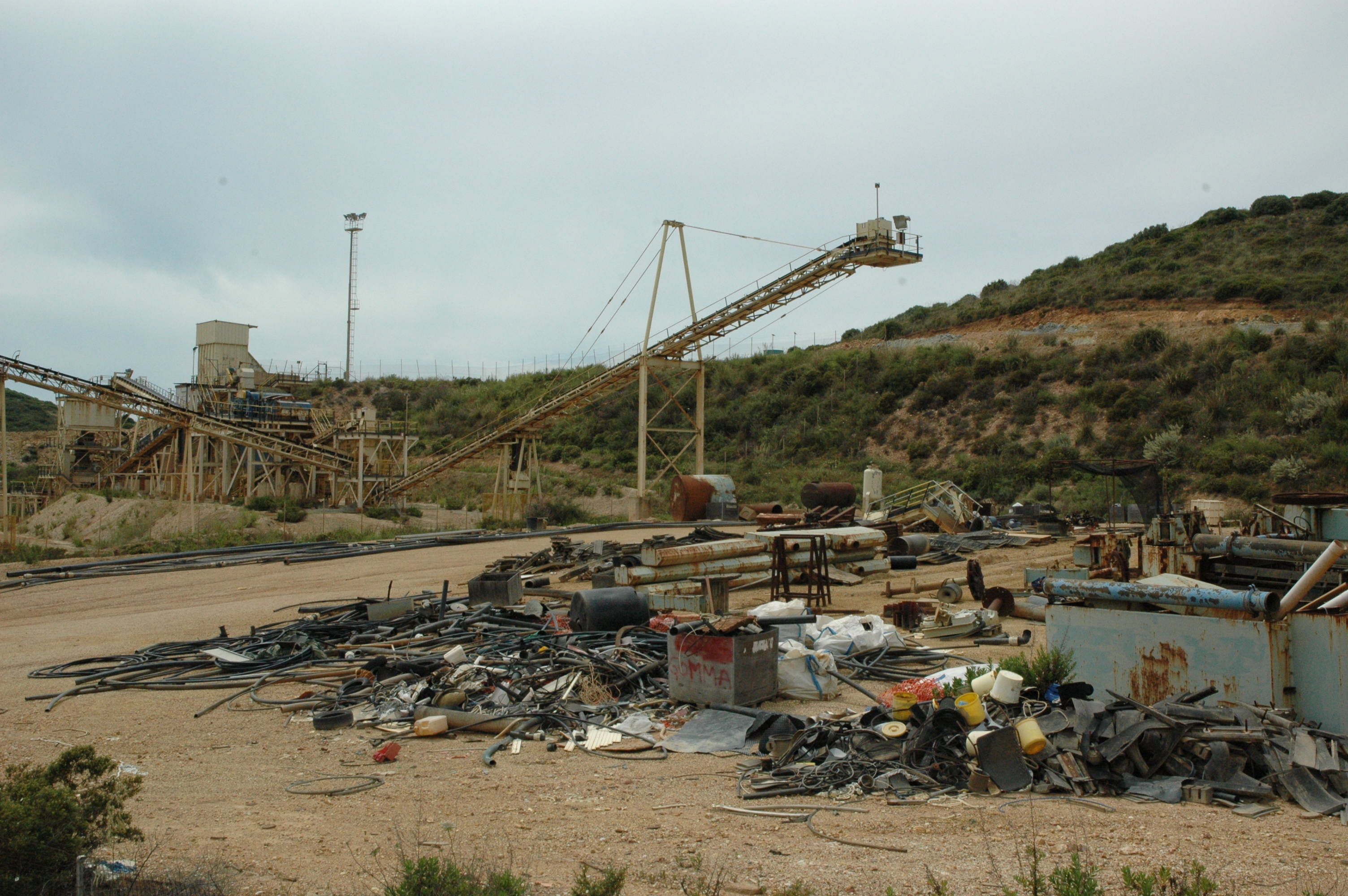
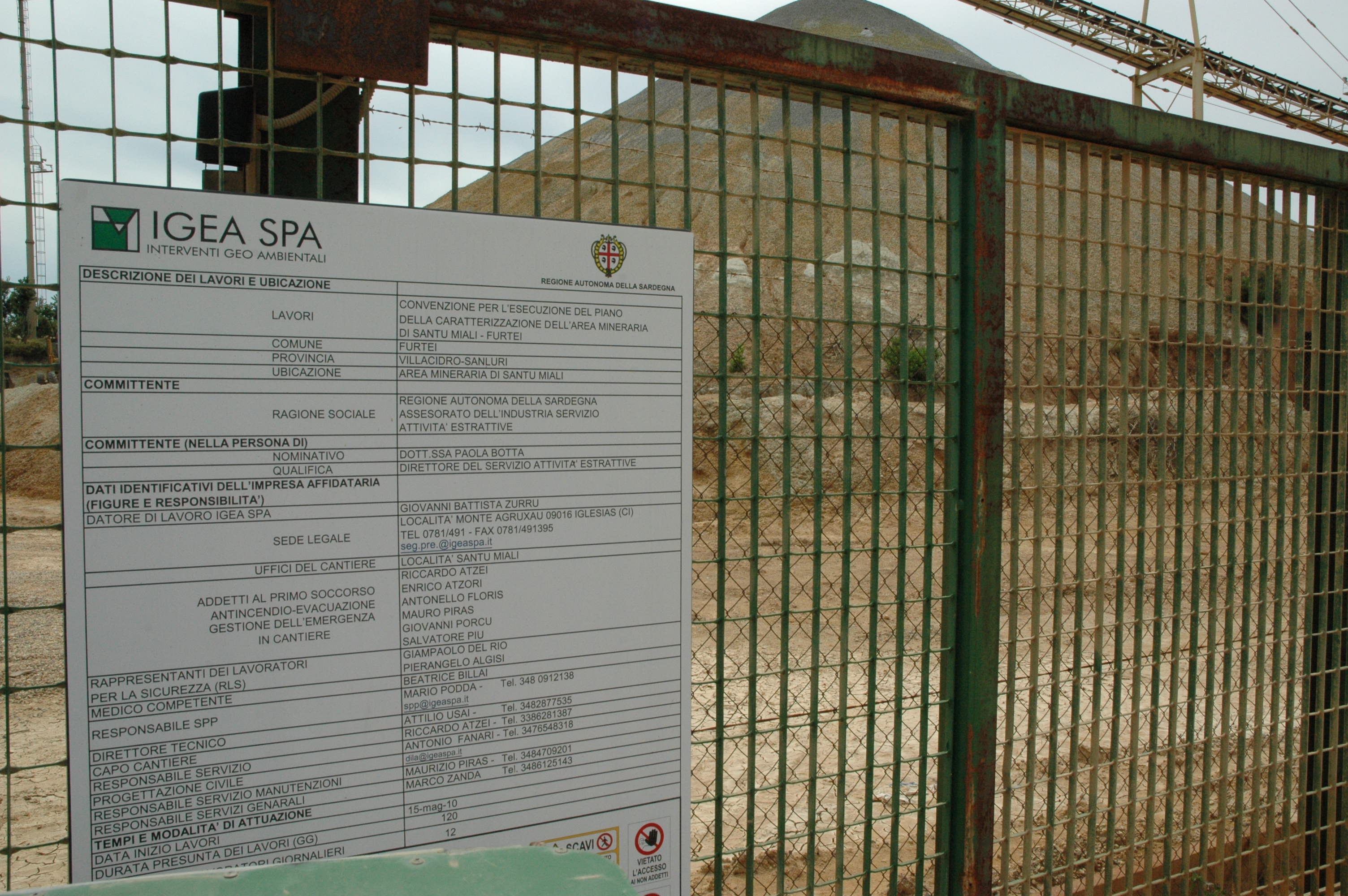
great reading.
http://www.willcoxrangenews.com/news/article_016dfe54-f795-11e1-89f0-001a4bcf887a.html
2009-12 State of emergency declared after spring 2009 floods and pollution fears, and Sardinian government maintains site, beginning remediation of heavy metals and cyanide at an initial cost of $25 million by 2012.
Hello
I was an investor of Gold Mines of Sardinia , listed on AIM market in 2003-2007
I also visited the mine as an independant investor in August 2004
I read this report with great interest
I confirm most of the facts described here
These people are obviously crooks
and a danger for local communities.
Pollution left to the goverment to fund
bad bad bad corporate guys!
victor